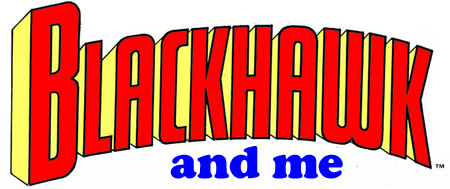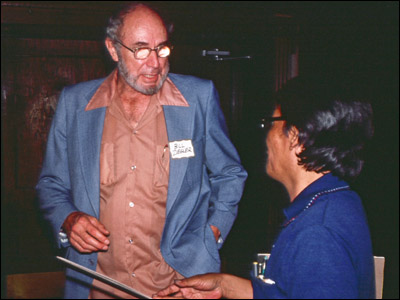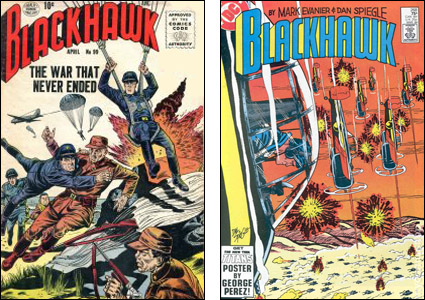Before you read this, you'll certainly want to read Part 1, Part 2, Part 3, Part 4, Part 5, Part 6 and Part 7…

Now then: When I took over as editor of Blackhawk, I was more involved in the design of covers and I had to handle the occasional submission from some writer who'd send me a pitch or even a complete Blackhawk script under the erroneous impression that I might be eager to replace myself. (Advice to aspiring writers: If you're going to go to any effort to apply for a job, apply for one that might be open.)
Also, it mattered a little more when I complained to the marketing people that the comic was not receiving the usual amount of promotion. That is not to suggest it changed anything. This was a battle that went on for the book's entire run and yes, I am well aware that almost no one ever thinks their comic has had sufficient promotion.
But I had a couple of egregious examples of neglect to point to, one being when the company did a big push for subscriptions. They advertised a good price to subscribe to any comic in the DC line…well, almost any comic. For reasons no one could explain — and I still haven't ruled out a mistake — Blackhawk was the only one not listed on the form. There were other examples I'll get to.
I still meet people who think the book was a top seller for DC. No, no, no, never. Not even close. It just sold better than anyone had expected, making a little money instead of losing. One thing that might have boosted sales a tad was that we had some splendid covers drawn by Dave Cockrum, Howard Chaykin and, near the end, Gil Kane.
There is a theory, and I'm not saying I subscribe to it or don't, that it helps the sales of a comic if the cover is not done by the person who does the interior. The thinking goes like this: You have Artist A drawing the story. He or she has a certain following and those followers will buy the comic. No more of them are going to buy it if Artist A does the cover but some followers of Artist B might buy the comic if Artist B does the cover.
It may have helped sales a bit more that some issues had short back-up stories that fell under the heading of "Detached Service Diary." This was a feature that had appeared in Blackhawk comics many, many years before I ever came near the franchise. There'd be a lead story with the whole Blackhawk Squadron and then there'd be a short story of one of the members of the team on a solo adventure. This was to put one character in the spotlight so we'd get to know him better and I suppose it also spared the artist having to draw as many pages with seven soldiers on them.
Sometimes, they wouldn't be "Detached Service Diary" stories. Sometimes, they'd flash back to the past and we'd get a "World War II Combat Diary." Same idea but set during those not-fun years. Since our new run of Blackhawk was wholly set in World War II, we didn't need any of those…but suddenly, Detached Service Diary stories became part of the overall plan.
It happened back when Dave Cockrum declined the offer to draw this new Blackhawk series. He said at the time something like, "If I have time, I'll do some covers and a couple of Detached Service Diary back-ups." No one had decided yet that we'd even have Detached Service Diary back-up stories but once Dave said that, everyone decided we would. I think I'd have preferred to just devote all 23 story pages in an issue to one story drawn by Dan Spiegle but that was not an option. And like I said, maybe the guest artists helped sales. We sure had some good ones.
Dave drew the first two. Then John Severin drew the next one. I wrote all of these with the specific artists in mind but Marv Wolfman, who was the editor at that moment, sent the second one I wrote for Dave to John and the first (and only) one I wrote for John to Dave. Intentionally. He thought it might yield some interesting results and I guess it did.
Both men did great jobs. I remember receiving copies of what John Severin had done. He was, of course, a long-time favorite and a perfect choice for that kind of material. The same day I received the copies, my amigo Sergio Aragonés dropped by my house and I showed the pages to him.
I expected him to say something like, "Wow! John Severin drawing Blackhawk! What a perfect match of a great artist with the right feature!" He had already said that about the pages he'd seen drawn by Dan Spiegle. Instead, he looked over the Severin story and said, "Uh-huh. Fine."
I said, "That's all you've got to say? 'Fine?' This is the first time John Severin ever drew Blackhawk!"
He said, "What do you mean? This artist drew Blackhawk for years." I told him that was not so. He said, "You're wrong. When I was a child in Mexico, I loved his work on this comic book. He was one of my favorites!"
It took a while but we finally cut through the confusion: When Sergio was a lad in Mexico, he read Mexican Blackhawk comic books drawn in Mexico. And one of the main artists who drew them there was a John Severin imitator…and not a bad one. He copied from comics John Severin had drawn in America.
The next back-up was drawn by Bill Ziegler. You may not know who that is — or rather, was. Bill died back in 1990. He was a lovely man who drew comic books and strips for about forty years. This one Blackhawk story was the only thing he ever drew for DC Comics and one of the few times he ever got his name on his work. He was mainly an assistant to others. He assisted on the Annie Oakley newspaper strip and the Dragnet newspaper strip and the Casey Ruggles newspaper strip and the Mary Worth newspaper strip. Near the end of his life, he became the lead artist on Mary Worth and actually got credit on it for a while.

Bill also assisted on the Katy Keene comic books and drew dozens of westerns and TV tie-in comics for Western Publishing for the Dell and Gold Key lines…all uncredited. I liked him and I liked his work and that's why I asked him to squeeze that story into his workload. After he saw it, DC head honcho Dick Giordano called me, got Bill's phone number and offered him a new book DC had in the works. Bill, alas, was already committed to Mary Worth and had to decline.
About this time, we had an odd problem I never would have expected. Dan Spiegle didn't have time to draw the next Blackhawk and it wasn't because he was slow. As I've mentioned here, he was one of the most dependable artists who ever worked in the industry. Folks at DC were so taken with his work and reliability that they were sending him other jobs on other books, including a couple that were in deadline danger. At first, he could fit them in between Blackhawk jobs but at some point, he couldn't start on my script because he had work he had to do for other editors first.
One of them was a Superman educational comic that was for RadioShack or some other company. I've never seen a copy of it so perhaps it was never published but it took up a few weeks of Dan's time and caused great consternation. The DC editor who engaged him and sent him the script neglected to also send Dan any reference on the established characters in it. DC had been sending him copies of all their current releases and he was able to find Superman, Clark Kent, Lois Lane and all the others…all but master villain Lex Luthor.
Dan called the editor and asked him to send reference on Lex Luthor. The editor said, "Oh, you don't need reference. Just draw Telly Savalas." Dan asked, "Are you sure?" The editor said, "Sure, it'll be fine." So Dan penciled and inked the comic and I think his daughter lettered it and he sent it in, whereupon the editor was horrified and sent it back for corrections…

…because Dan had drawn Telly Savalas. It didn't look like Lex Luthor, at least the way Luthor was being drawn then. It looked like Telly Savalas. Not all bald guys are indistinguishable from one another. I hope they paid Dan extra for redrawing all the panels he had to redraw.
I was not yet editor of Blackhawk at this point but I complained — politely and good-naturedly, as is my style — about other editors kidnapping my lead artist for their needs. I had the same problem when I wrote a forgettable New Gods series for them. Mr. Giordano was, as he always was, polite and good-natured but he explained to me how DC needed to position its freelancers where they'd do the most good. I think Dan had committed the dangerous mistake of turning in work ahead of the deadline. That always made them think he could handle more.
Anyway, with all these demands on his time, we were facing a deadline problem on the next issue on Blackhawk. In the next chapter of this series, I'll tell you how we solved it and also more about the Detached Service Diary stories.
But I want to cover one other thing, lest I forget: The BLACKHAWK logo that adorns this series of articles was the logo designed for our revival and it was designed by Tom Orzechowski. Tom's lettering and logos have brightened many a Marvel comic but I believe this is the only cover logo he ever did for DC. I further believe know that DC staffer Anthony Tollin was a big Blackhawk fan, knew Tom was one too, and suggested him for the assignment.

The classic BLACKHAWK logo that appeared on most of the covers when the comic was published by Quality Comics and then taken over by DC, was designed by a gent named Al Grenet, who was an artist and staffer and editor for Quality. Orz (as folks too lazy to type out "Orzechowski" call him) took that logo, tweaked and reshaped it and wound up with, I think, a much better design. Logo designers just never seem to get enough credit in comics. They probably have more impact on sales than most folks realize…and I've certainly seen comics where I thought the best thing in them was the lettering by Orz.
Click here to jump to the next part of this seemingly-endless article